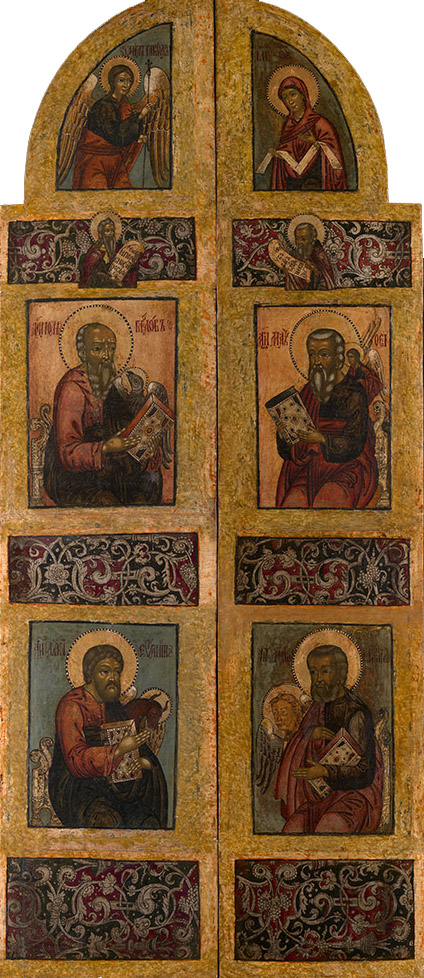MacDougall Auctions 2-3 December 2009
2 December 2009

92. AN IMPORTANT PAIR OF ROYAL DOORS DEPICTING THE ANNUNCIATION, THE FOUR EVANGELISTS, THE PROPHET ELIJAH AND A HOLY VENERABLE
ROSTOV REGION (BELOZERYE), LATE 17TH CENTURY
169.5 by 37 each
100,000-120,000 pounds
These Royal Doors reflects some of the iconographic changes that took place in the 17th century in connection with the masters of the Armoury School and may be specifically related to a set of Royal Doors, dated 1653, at the Dormition Cathedral, Moscow Kremlin. Their distinctive feature is the representation of all the figures in close- up, half-length view rather than full-length. Another innovation – introduced in the 1670-80s by Simon Ushakov – is the appearance of their celestial symbols intimately alongside each of the Evangelists: the Angel with Matthew and the Ox with Luke, and specifically the Lion with Mark and the Eagle with John. These two latter symbols were assigned to John and Luke by St Jerome and indicate the influence of the Western tradition. This iconography became widespread in the following two decades in the Volga region and beyond. Also notable are the Evangelists’ carved thrones with their figurative and decorative motifs of faces, which symbolize their role as authors who sat down to write the New Testament; such stylization does not appear in metropolitan examples.
The Royal Doors demonstrate a number of unique features that have no equivalent in Russian icon-painting. These are the yellow and green backgrounds of the Evangelists’ scenes and the highly decorative, coloured panels that separate one scene from another with elaborate foliate ornamentation imitating silver niello over a red and green background. This ornament is reminiscent of a set of carved wooden Royal Doors, popular in late 17th century Russian art, the closest analogy being the carved Royal Doors from the Church of the Ascension (1669) at Kusherka (Onega district), now in the Museum of Fine Arts of the Archangel Region. It is also very close to the patterns favoured by the Rostov icon-painters in the late 17th century.
Another unique iconographic feature is the Bishop’s stole (omophorion) being held by the Virgin Mary in the Annunciation scene, and which is similar to the imagery found in medallions of “St Nicholas the Wonder-Worker and the Miracles of Nicea” icons. The most unusual element, however, are the images of the Prophet Elijah and a Venerable who hold extended scrolls. The Royal Doors are most likely of monastic origin, since the representation of the Venerable closely follows that of the monastic saints Sergius of Radonezh, Abraham of Rostov, and Zosimas of Solovki; this is further confirmed by the presence of Elijah, who in Russia was often considered (particularly in remote areas) a forerunner of the ascetic, monastic lifestyle. The presence of the Venerable, whose name unfortunately no longer survives, clearly suggests that the Doors originate from a cathedral dedicated to him. Although the style of the Royal Doors, especially in the modelling of the faces, can be traced back to the Armoury tradition, their manner of execution suggests a provincial area of the Rostov diocese as the place of their origin, most likely the regions of Belozersk or Veliky Ustuyg, where examples of this style of icon-painting are often found.
Notes on symbols:
* Indicates 5% Import Duty Charge applies.
Ω Indicates 20% Import Duty Charge applies.
§ Indicates Artist's Resale Right applies.
† Indicates Standard VAT scheme applies, and the rate of 20% VAT will be charged on both hammer price and premium.